2018 MERCEDES-BENZ CLA brakes
[x] Cancel search: brakesPage 149 of 326
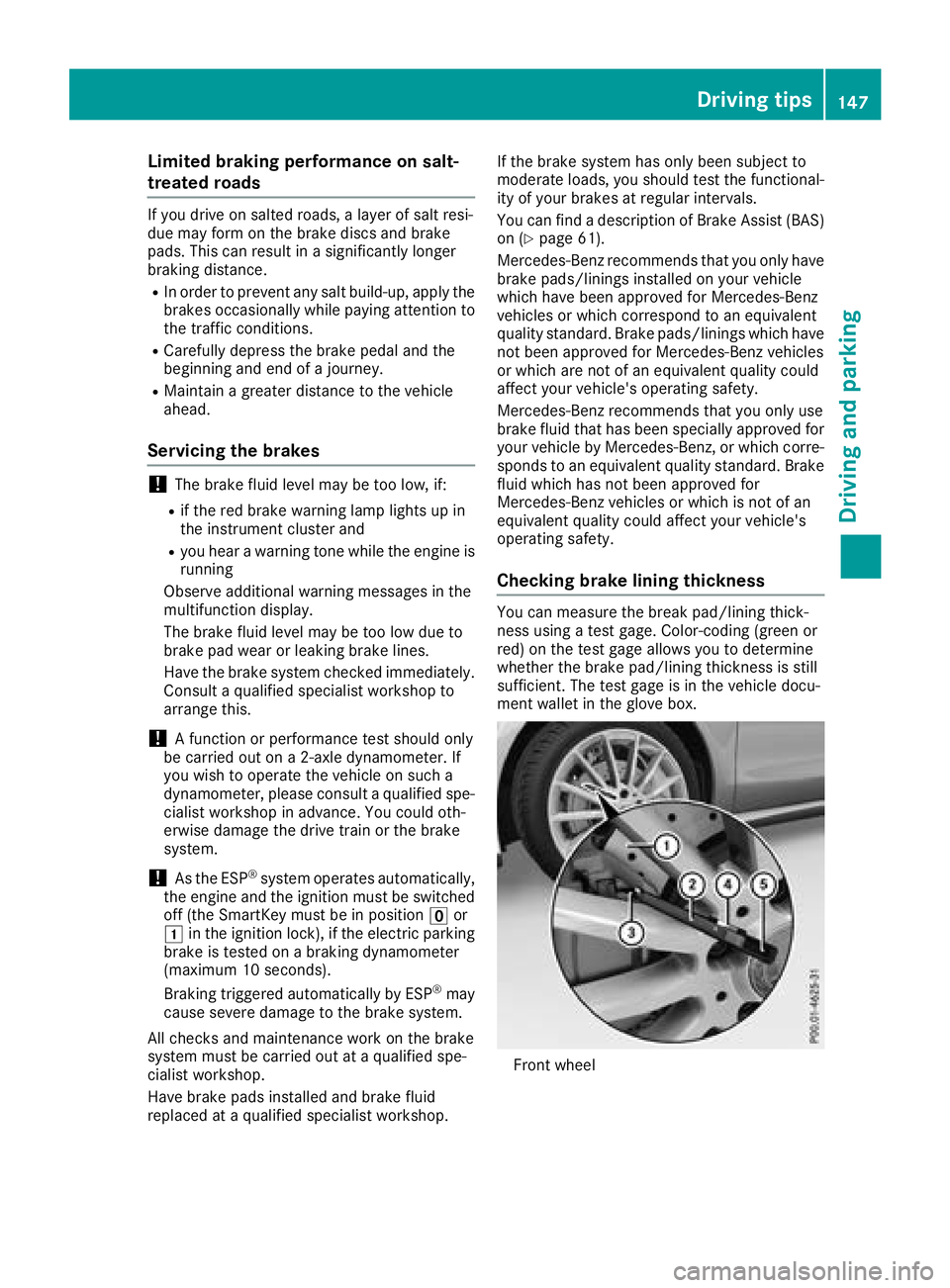
Limited braking performance on salt-
treated roads If you driv eons alted roads ,al ayer of salt resi-
due may for mont he brak ed isc sa nd brake
pads. This can result in as ignificantly longer
braking distance. R
In orde rtop revent any salt build-up, apply the
brakes occasionally while paying attention to
th et ra ffic conditions.R
Carefully depress th eb rak ep edal and the
beginnin ga nd end of aj ou rney.R
Maintain ag reater distanc etot he vehicle
ahead.
Servicing th eb rakes
! The brak ef luid level may be to ol ow, if:R
if th er ed brak ew arning lamp light supi n
th ei nstrumen tc luster andR
you hear aw arning tone while th ee ngine is
running
Observe additional warning messages in the
multifunction display.
The brak ef luid level may be to ol ow due to
brak ep ad wear or leaking brak el ines.
Hav et he brak es ystem checked immediately.
Consult aq ualifie ds pecialist workshop to
arrange this.
! Af unction or performanc et es ts hould only
be carried out on a2 -a xle dynamometer. If
you wish to operate th ev ehicle on such a
dynamometer, please consult aq ualifie ds pe-
cialis tw orkshop in advance. You could oth-
erwis ed amage th ed riv et ra in or th eb rake
system.
! As th eE SP ®
system operates automatically,
th ee ngine and th ei gnitio nm ust be switched
off (th eS ma rtKey must be in position �
Page 151 of 326
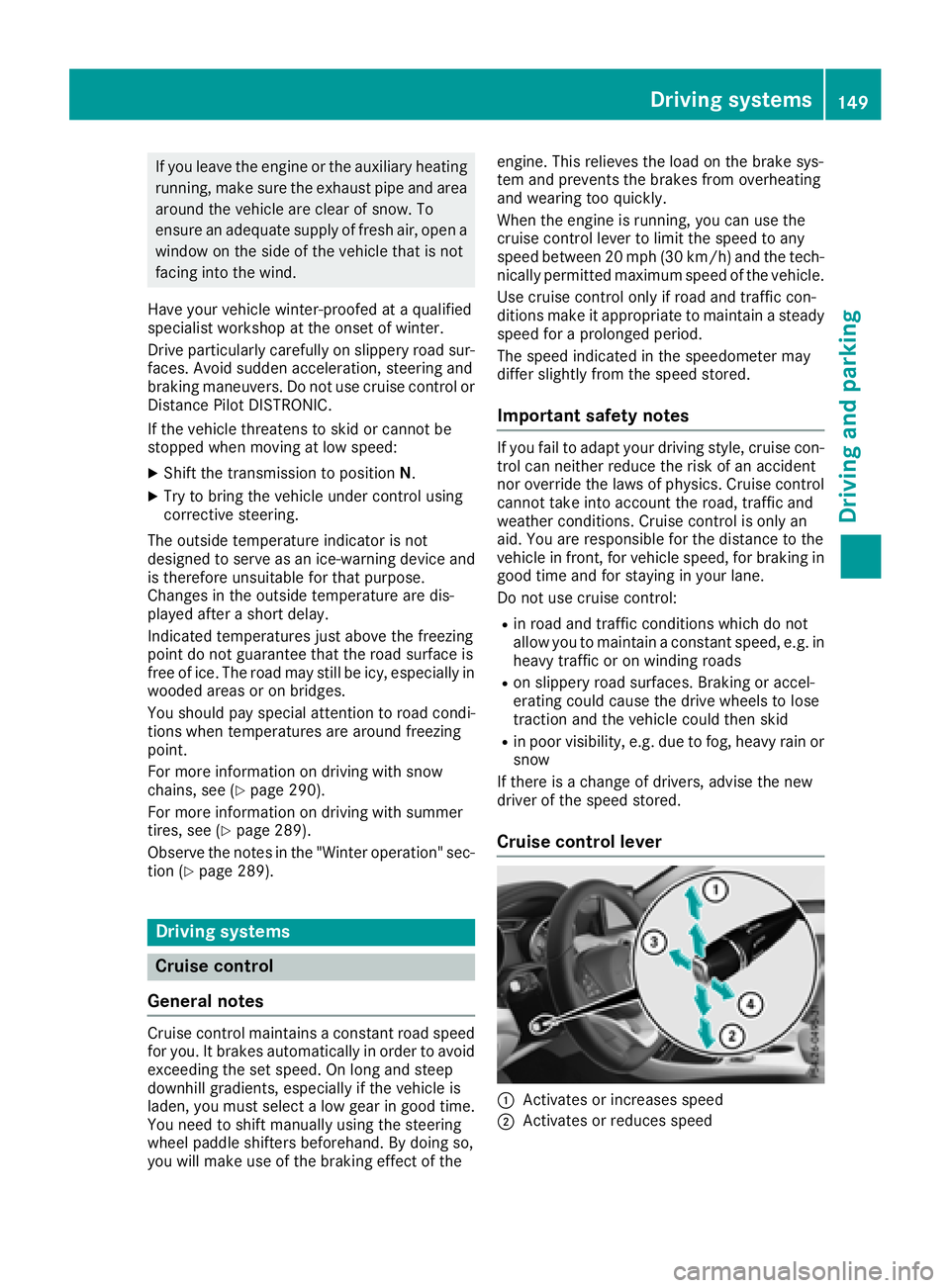
If you leave the engine or the auxiliary heating
running, make sure the exhaust pipe and area
around the vehicle are clear of snow. To
ensure an adequate supply of fresh air, open a
window on the side of the vehicle that is not
facing into the wind.
Have you rv ehicle winter-proofed at aq ualified
specialist workshop at the onset of winter.
Drive particularly carefully on slippery road sur-
faces. Avoid sudden acceleration, steering and
braking maneuvers. Do not use cruise control or
Distance Pilo tD ISTRONIC.
If the vehicle threatens to skid or cannot be
stopped when moving at low speed: X
Shift the transmission to position N .X
Try to bring the vehicle under control using
corrective steering.
The outsid et emperature indicator is not
designed to serve as an ice-warning device and
is therefore unsuitable for that purpose.
Changes in the outsid et emperature are dis-
played after as hort delay.
Indicated temperature sj ust above the freezing
point do not guarantee that the road surface is
free of ice. The road may still be icy, especially in
woode da rea soronb ridges.
You shoul dp ay specia la ttention to road condi-
tions when temperature sa re around freezing
point.
For more information on driving with snow
chains, see ( Y
page 290).
For more information on driving with summer
tires, see ( Y
page 289).
Observe the notes in the "Winter operation" sec-
tion ( Y
page 289).
Drivin gs ystems
Cruise control
General notes
Cruise control maintains ac onstant road speed
for you .Itb rakes automatically in order to avoid
exceeding the set speed .Onl ong and steep
downhill gradients, especially if the vehicle is
laden, you must select al ow gear in good time.
You need to shift manually using the steering
wheel paddle shifters beforehand. By doing so,
you wil lm ake use of the braking effect of the engine. This relieves the load on the brake sys-
tem and prevents the brakes from overheating
and wearing too quickly.
When the engine is running, you can use the
cruise control lever to limi tt he speed to any
speed betwee n20m ph (30 km/h )a nd the tech-
nicall yp ermitted maximum speed of the vehicle.
Use cruise control only if road and traffic con-
ditions make it appropriate to maintain as teady
speed for ap rolonge dp eriod.
The speed indicated in the speedometer may
differ slightly from the speed stored.
Important safety notes If you fail to adapt you rd riving style, cruise con-
trol can neither reduce the risk of an accident
nor override the law sofp hysics. Cruise control
cannot take into account the road, traffic and
weather conditions. Cruise control is only an
aid .Y ou are responsible for the distance to the
vehicle in front, for vehicle speed ,f or braking in
good time and for staying in you rl ane.
Do not use cruise control: R
in road and traffic conditions which do not
allow you to maintain ac onstant speed ,e .g. in
heavy traffic or on winding roads R
on slippery road surfaces .B raking or accel-
erating could cause the drive wheel stol ose
traction and the vehicle could then skid R
in poor visibility, e.g. due to fog, heavy rain or
snow
If there is ac hange of drivers, advise the new
driver of the speed stored.
Cruise control lever
�C
Activates or increases speed
�D
Activates or reduces speedDriving systems 149
Driving and parking Z
Page 153 of 326
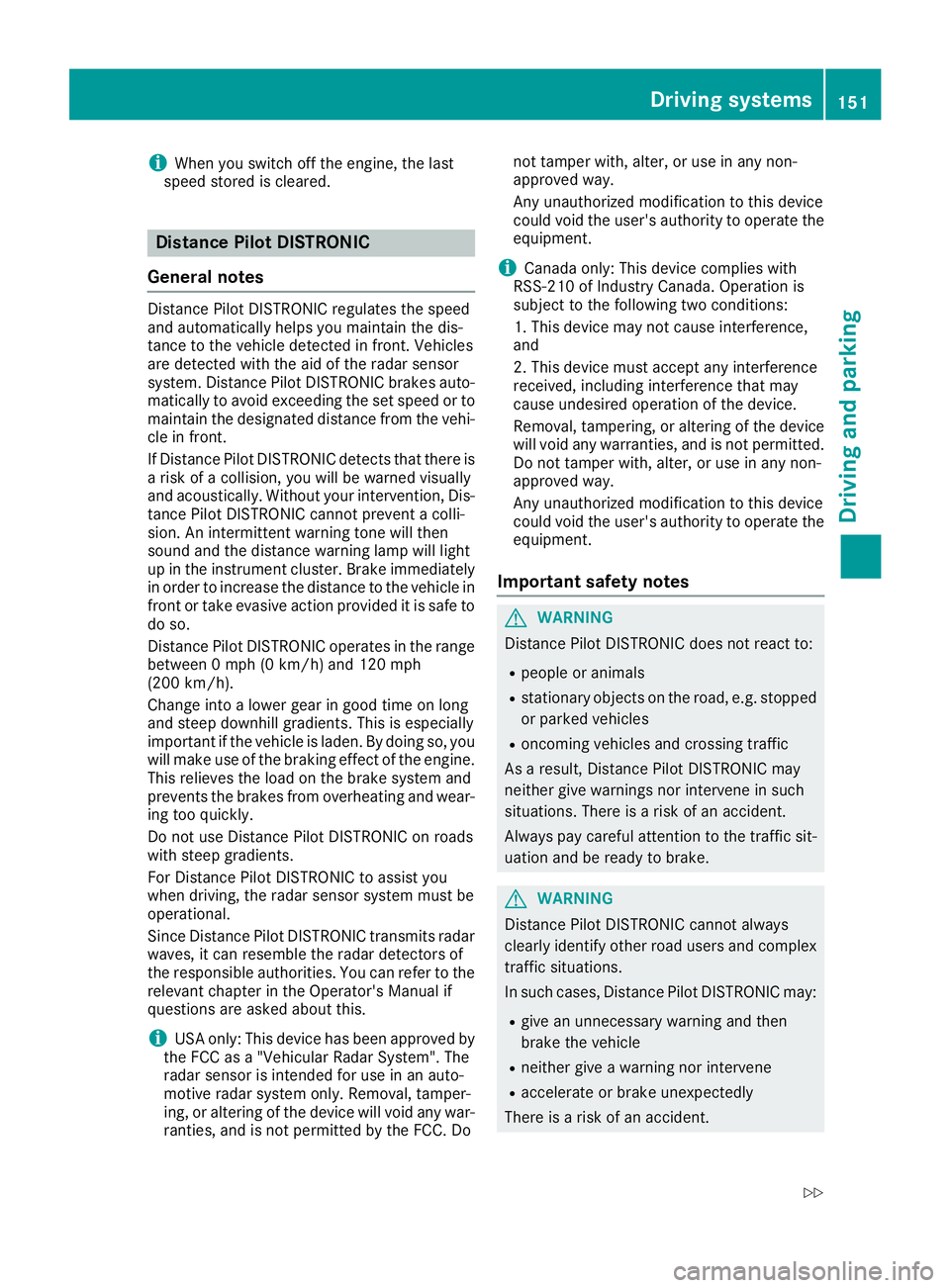
i When you switch off the engine, the last
speed stored is cleared.
Distance Pilot DISTRONIC
General notes Distance Pilot DISTRONIC regulates the speed
and automatically helps you maintain the dis-
tanc etot he vehicle detected in front. Vehicles
are detected with the aid of the radar sensor
system. Distance Pilot DISTRONIC brakes auto-
matically to avoid exceedin gt he set speed or to
maintain the designated distanc ef rom the vehi-
cle in front.
If Distance Pilot DISTRONIC detect st hat there is
ar isk of ac ollision, you will be warned visually
and acoustically. Without your intervention, Dis-
tanc eP ilot DISTRONIC cannot prevent ac olli-
sion. An intermittent warning ton ew ill then
sound and the distanc ew arning lamp will light
up in the instrument cluster. Brake immediately
in order to increase the distanc etot he vehicle in
fron tort ake evasive action provided it is safe to
do so.
Distance Pilot DISTRONIC operates in the range
between 0m ph (0 km/h) and 120 mph
(200 km/h).
Change into al ower gear in good time on long
and steep downhill gradients .T his is especially
importan tift he vehicle is laden. By doing so, you
will make use of the braking effect of the engine.
This relieves the load on the brake system and
prevent st he brakes from overheatin ga nd wear-
ing too quickly.
Do not use Distance Pilot DISTRONIC on roads
with steep gradients.
For Distance Pilot DISTRONIC to assist you
when driving, the radar sensor system must be
operational.
Sinc eD istance Pilot DISTRONIC transmits radar
waves, it can resemble the radar detectors of
the responsible authorities. You can refer to the
relevant chapter in the Operator' sM anual if
questions are asked about this.
i USA only: This device has been approved by
the FCC as a" Vehicular Radar System". The
radar sensor is intended for use in an auto-
motive radar system only. Removal, tamper-
ing, or altering of the device will void any war-
ranties, and is not permitted by the FCC. Do not tamper with, alter, or use in any non-
approved way.
An yu nauthorized modification to this device
could void the user's authority to operate the
equipment.
i Canada only: This device complies with
RSS-210 of Industry Canada. Operation is
subject to the following two conditions:
1. This device may not cause interference,
and
2. This device must accept any interference
received, including interference that may
cause undesired operation of the device.
Removal, tampering, or altering of the device
will void any warranties, and is not permitted.
Do not tamper with, alter, or use in any non-
approved way.
An yu nauthorized modification to this device
could void the user's authority to operate the
equipment.
Important safety notes
G WARNING
Distance Pilot DISTRONIC does not react to: R
people or animals R
stationary object sont he road, e.g. stopped
or parked vehicles R
oncoming vehicles and crossin gt raffic
As ar esult, Distance Pilot DISTRONIC may
neither give warnings nor intervene in such
situations. There is ar isk of an accident.
Always pay careful attention to the traffic sit-
uation and be ready to brake.
G WARNING
Distance Pilot DISTRONIC cannot always
clearly identif yo ther road users and complex
traffic situations.
In such cases, Distance Pilot DISTRONIC may: R
give an unnecessary warning and then
brake the vehicle R
neither give aw arning nor intervene R
accelerat eorb rake unexpectedly
There is ar isk of an accident.Driving systems 151
Driving and parking Z
Page 154 of 326
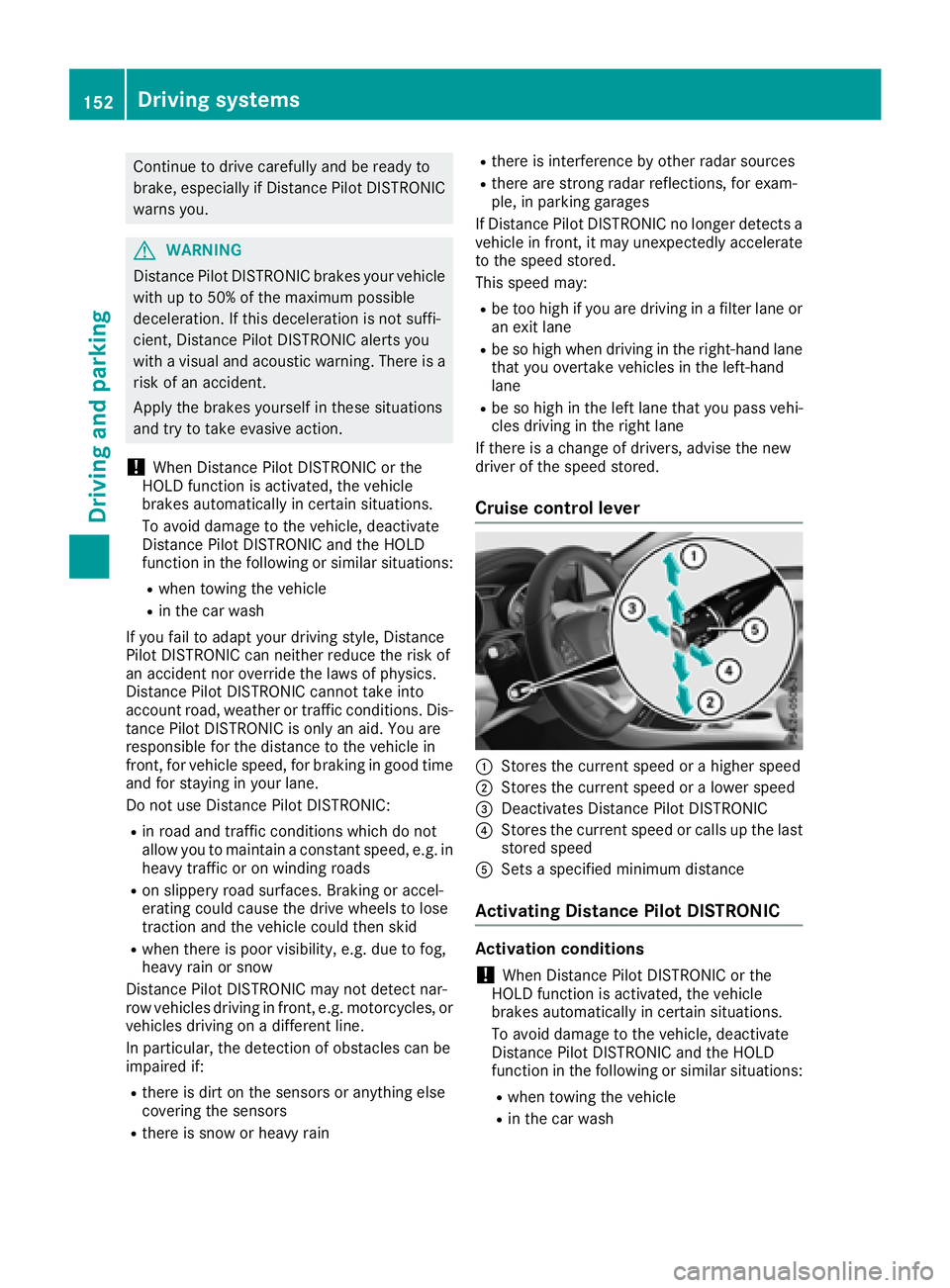
Continue to driv ec arefull ya nd be read yt o
brake, especiall yifD is tance Pilot DI ST RONIC
warn sy ou.
G WAR NING
Distance Pilot DI ST RONI Cb rakes your veh icle
wit hupt o5 0% of th em aximum poss ible
deceleration. If th is deceleratio nisn ot suff i-
cient ,D is tance Pilot DI ST RONI Ca lert sy ou
wit hav is ual and acoust ic warning .T her eisa
ris kofana cc iden t.
Ap ply th eb rakes yourself in these situations
and tr yt ot ak ee vasive action.
! When Distance Pilot DI ST RONI Co rt he
HOLD function is activated, th ev eh icle
brakes automaticall yinc ertain situations.
To avoid damag etot he veh icle ,d eactivate
Distance Pilot DI ST RONI Ca nd th eH OL D
function in th ef oll owin gors imilar situations:R
when to wing th ev eh icleR
in th ec ar wash
If you fail to adapt your driv ing style, Distance
Pilot DI ST RONI Cc an neither reduce th er is ko f
an acc iden tn or overr ide th el aws of physics.
Distance Pilot DISTRONI Cc anno tt ak ei nto
accoun tr oad ,w eather or traff ic conditions .D is -
tance Pilot DI ST RONI Ci so nl yana id. You are
respon sible for th ed istanc etot he veh icle in
front, for veh icle spee d, for braking in good time
and for staying in your lane.
Do no tu se Distance Pilot DI ST RONI C:R
in road and traff ic conditions whic hdon ot
allow you to maintain ac onstant spee d, e.g .i n
heav yt ra ff ic or on wind ing roadsR
on slipp ery road surfaces .B ra kin gora ccel-
erating could caus et he driv ew heel stol ose
t r action and th ev eh icle could then sk idR
when there is poor vis ibilit y, e.g .d ue to fog,
heav yr ain or snow
Distance Pilot DI ST RONI Cm ay no td etect nar-
row veh icle sd riving in front, e.g .m otorcycles, or
veh icle sd riving on ad ifferent lin e.
In particular ,t he detection of obstacle sc an be
impaired if: R
there is dirt on th es ensor sora nythin ge lse
covering th es ensorsR
there is snow or heav yr ain R
there is interferenc ebyo th er radar sourcesR
there are stron gr adar reflections ,f or exam-
ple, in parking garages
If Distance Pilot DI ST RONI Cn ol onger detect sa
vehicle in front, it may unexpect edly accelerate
to th es pee ds to re d.
This spee dm ay: R
be to oh igh if you are driving in af ilter lane or
an ex it lane R
be so high when driving in th er ight-han dl ane
that you overtake vehicle sint he left-hand
lane R
be so high in th el eft lane that you pass vehi-
cle sd riving in th er igh tl ane
If there is ac ha ng eofd rivers ,a dvis et he new
driv er of th es pee ds to re d.
Cruise control lever
�C
St ore st he curren ts pee dorah igher speed�D
Store st he curren ts pee doral ower speed�
Page 156 of 326

accelerate sm or eg ently. This settin gisr ecom-
mended in stop-and-start traffic.
Changing lanes If when driving on multilane roads you wish to
chang etot he overtakin gl ane ,D istance Pilot
DISTRONIC support sy ou if:R
you are driving faster than 45 mph (70 km/ h)R
Distance Pilo tD ISTRONI Ci sm ai ntaining the
distance to av ehicl einf rontR
yo us wi tch on the appropriate tur ns ig nalR
Distance Pilo tD ISTRONI Cd oe sn ot currently
detect ad an ge rofc ollision
If these conditions ar ef ul filled ,y ou rv ehicl ei s
accelerated .A cceleratio nw il lbei nterrupte di f
changing lanes take st oo long or if the distance
between your vehicl ea nd the vehicl einf ront
become st oo small.
Stopping If Distance Pilo tD ISTRONI Cd et ects tha tt he
vehicl einf ront is stopping, it brakes your vehicle
unti litiss tationary.
Once your vehicl eiss tationary, it remains sta-
tionar ya nd yo udon ot nee dtod ep ress the
brake.
i After at ime ,t he electri cp ar kin gb rake
secures the vehicl ea nd relieves the service
brake.
i Depending on the specifie dm inimu md is -
tance ,y ou rv ehicl ew il lc ome to as tandstil la t
as uf ficient distance behind the vehicl ei n
front. The specifie dm inimu md is tance is set
using the contro lont he cruis ec o ntro ll ev e
r.
When Distance Pilo tD ISTRONI Ci sa ctivated,
the transmission is shifted automaticall yt o
position �] if:R
the driver's sea tb el tisn ot fastened and the
driver's door is open. R
the engine is switched off ,u nless it is auto-
maticall ys wi tched off by the ECO start/stop
function.
The electri cp ar kin gb rake secures the vehicle
automaticall yifD istance Pilo tD ISTRONI Ci s
activated when the vehicl eiss tationar ya nd:R
as ys tem malfunctio no ccurs.R
the powe rs uppl yisi nsufficient.
If am al functio no ccurs, the transmission may
also shift to position �] automatically. Settin gas peedKee pinm in dt ha titm ay take ab rief moment
unti lt he vehicl eh as accelerated or braked to
the spee ds et. X
Press the cruis ec ontro ll ev er up �C for a
highe rs peed or down �D for al ower speed.X
To adjus tt he se ts peed in 1m ph incre-
ments (1 km/ hi nc rements): briefl yp ress
the cruis ec ontro ll ev er up �C or down �D to
the pressure point.
The last stored spee di ncreases or decreases
in 1m ph (1 km/h )i ncrements.X
To adjus tt he se ts peed in 5m ph incre-
ments (1 0k m/h increments): briefly press
the cruise control lever up �C or down �D
beyond the pressure point.
The last stored speed increases or decreases
in 5m ph (10 km/h) increments.
i Distance Pilot DISTRONIC is not deactivated
if you depress the accelerator pedal. If you
accelerat etoo vertake, Distance Pilot
DISTRONIC adjusts the vehicle's speed to the
last speed stored after you have finished over-
taking.
Setting as pecified minimum distanceYou can set the specified minimum distanc ef or
Distance Pilot DISTRONIC by varying the time
span between one and two seconds. With this
function you can set the minimum distanc et hat
Distance Pilot DISTRONIC maintains to the vehi-
cle in front, dependen tonv ehicle speed. You
can see this distanc eint he multifunction dis-
play ( Y
page 161).
The specified minimum distanc ec an be
changed while Distance Pilot DISTRONIC is
switched on or off.
i Make sure that you maintain the minimum
distanc etot he vehicle in fron tasr equired by
law. Adjust the distanc etot he vehicle in front
if necessary.154
Driving systems
Driving and parking
Page 159 of 326
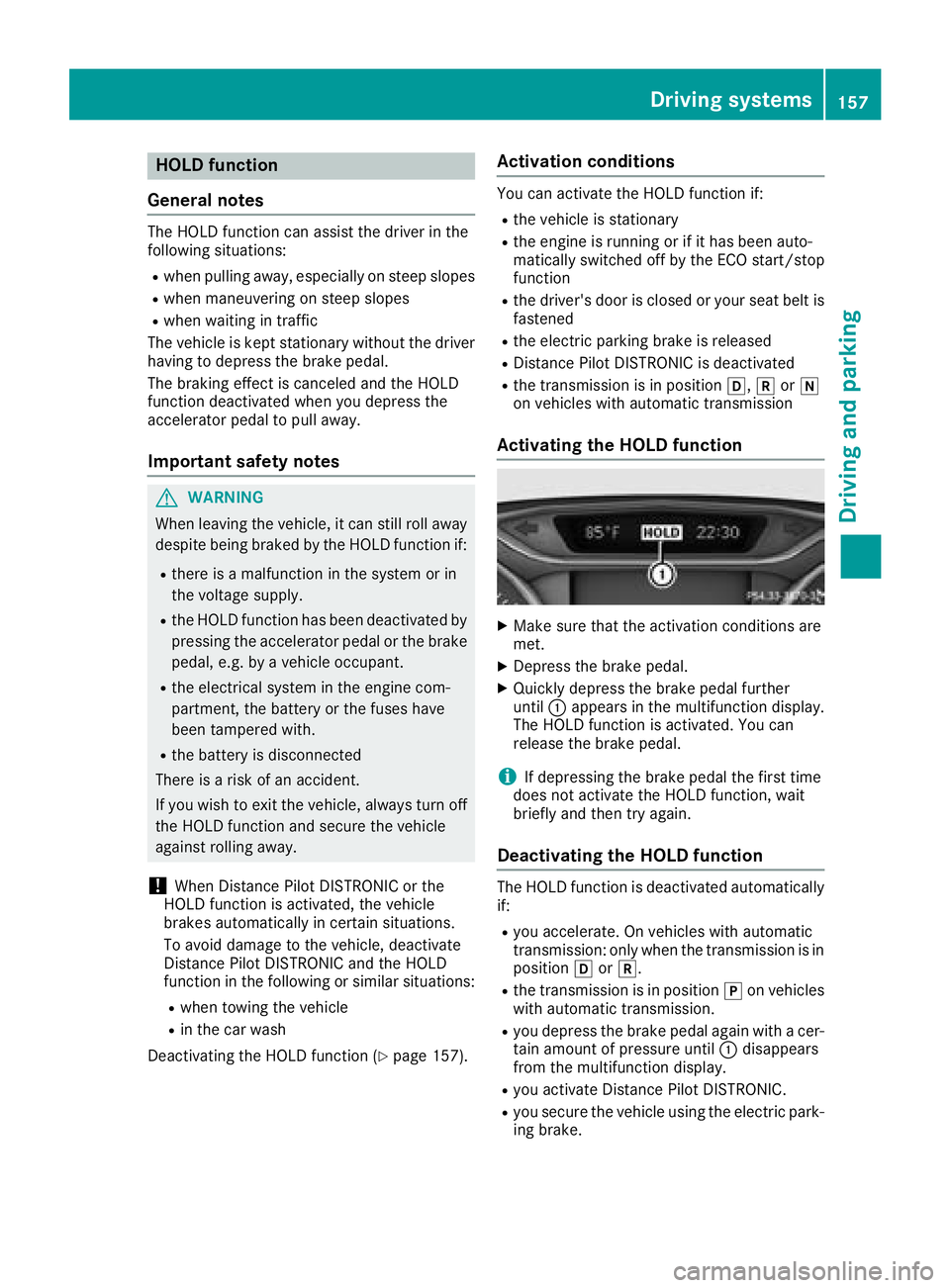
HOLD function
General notes The HOLD function can assist the drive rint he
following situations: R
when pulling away, especially on steep slopes R
when maneuvering on steep slopes R
when waiting in traffic
The vehicl eisk ept stationary without the driver
having to depress the brake pedal.
The braking effect is cancele da nd the HOLD
function deactivated when you depress the
accelerator peda ltop ul la way.
Important safety notes
G WARNING
When leaving the vehicle, it can still roll away
despite being braked by the HOLD function if: R
there is am alfunction in the system or in
the voltag es upply.R
the HOLD function has been deactivated by
pressing the accelerator peda lort he brake
pedal, e.g. by av ehicl eo ccupant.R
the electrical system in the engine com-
partment, the battery or the fuse sh ave
been tampere dw ith.R
the battery is disconnected
There is ar isk of an accident.
If you wis htoe xit the vehicle, alway st urn off
the HOLD function and secure the vehicle
against rolling away.
! When Distance Pilot DISTRONIC or the
HOLD function is activated, the vehicle
brakes automatically in certain situations.
To avoi dd amage to the vehicle, deactivate
Distance Pilot DISTRONIC and the HOLD
function in the following or similar situations: R
when towing the vehicle R
in the car wash
Deactivating the HOLD function ( Y
pag e1 57). Activation conditions You can activate the HOLD function if: R
the vehicl eiss tationary R
the engine is running or if it has been auto-
matically switched off by the ECO start/stop
function R
the driver's door is closed or you rs eat bel ti s
fastened R
the electric parking brake is released R
Distance Pilot DISTRONIC is deactivated R
the transmission is in position �[ , �^ or �\\
on vehicles with automatic transmission
Activating the HOLD function X
Make sure that the activation conditions are
met. X
Depress the brake pedal. X
Quickly depress the brake peda lf urther
until �C appears in the multifunction display.
The HOLD function is activated. You can
release the brake pedal.
i If depressing the brake peda lt he first time
does not activate the HOLD function, wait
briefly and then try again.
Deactivatin gt he HOLD functionThe HOLD function is deactivated automatically
if: R
you accelerate. On vehicles with automatic
transmission: only when the transmission is in
position �[ or �^ . R
the transmission is in position �] on vehicles
with automatic transmission. R
you depress the brake peda la gain with ac er-
tain amount of pressure until �C disappears
from the multifunction display. R
you activate Distance Pilot DISTRONIC. R
you secure the vehicl eu sing the electric park-
ing brake.Driving systems 157
Driving and parking Z
Page 163 of 326
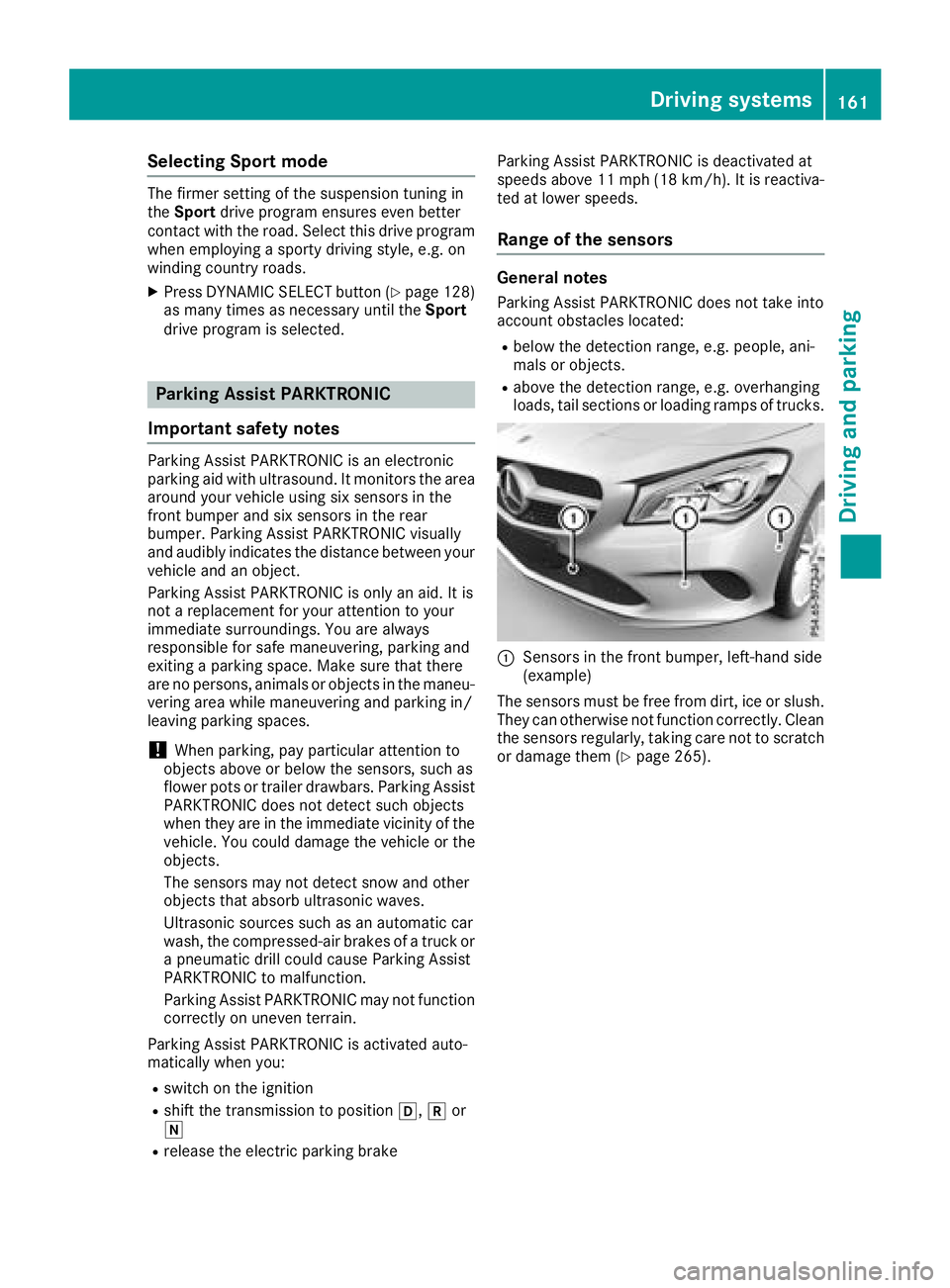
Selecting Sport mode The firmer settin goft he suspension tuning in
the Sport drive program ensures even better
contact with the road. Select this drive program
when employing as porty driving style, e.g. on
winding countr yr oads.X
Press DYNAMI CS ELECT button ( Y
page 128)
as many times as necessary until the Sport
drive program is selected.
Parking Assist PARKTRONIC
Important safety notes Parking Assist PARKTRONIC is an electronic
parking aid with ultrasound. It monitor st he area
around your vehicle using six sensors in the
front bumper and six sensors in the rear
bumper. Parking Assist PARKTRONIC visually
and audibly indicates the distance between your
vehicle and an object.
Parking Assist PARKTRONIC is only an aid. It is
not ar eplacement for your attention to your
immediate surroundings. You are always
responsible for safe maneuvering, parking and
exiting ap arking space. Make sure that there
are no persons, animals or object sint he maneu-
vering area while maneuvering and parking in/
leaving parking spaces.
! When parking, pay particular attention to
object sa bove or below the sensors, such as
flower pots or trailer drawbars. Parking Assist
PARKTRONIC does not detect such objects
when they are in the immediate vicinity of the
vehicle. You could damage the vehicle or the
objects.
The sensors may not detect snow and other
object st hat absorb ultrasonic waves.
Ultrasonic sources such as an automatic car
wash, the compressed-air brakes of at ruck or
ap neumatic drill could cause Parking Assist
PARKTRONIC to malfunction.
Parking Assist PARKTRONIC may not function
correctly on uneven terrain.
Parking Assist PARKTRONIC is activated auto-
matically when you: R
switch on the ignition R
shift the transmission to position �[ , �^ or
�\\ R
release the electric parking brake Parking Assist PARKTRONIC is deactivated at
speeds above 11 mph (18 km/h). It is reactiva-
ted at lower speeds.
Range of the sensors General notes Parking Assist PARKTRONIC does not take into
account obstacles located: R
below the detection range, e.g. people, ani-
mals or objects. R
above the detection range, e.g. overhanging
loads, tail section sorl oading ramps of trucks.
�C
Sensors in the front bumper, left-hand side
(example)
The sensors must be free from dirt, ice or slush.
They can otherwise not function correctly. Clean
the sensors regularly ,t aking care not to scratch
or damage them ( Y
page 265).Driving systems 161
Driving and parking Z
Page 264 of 326
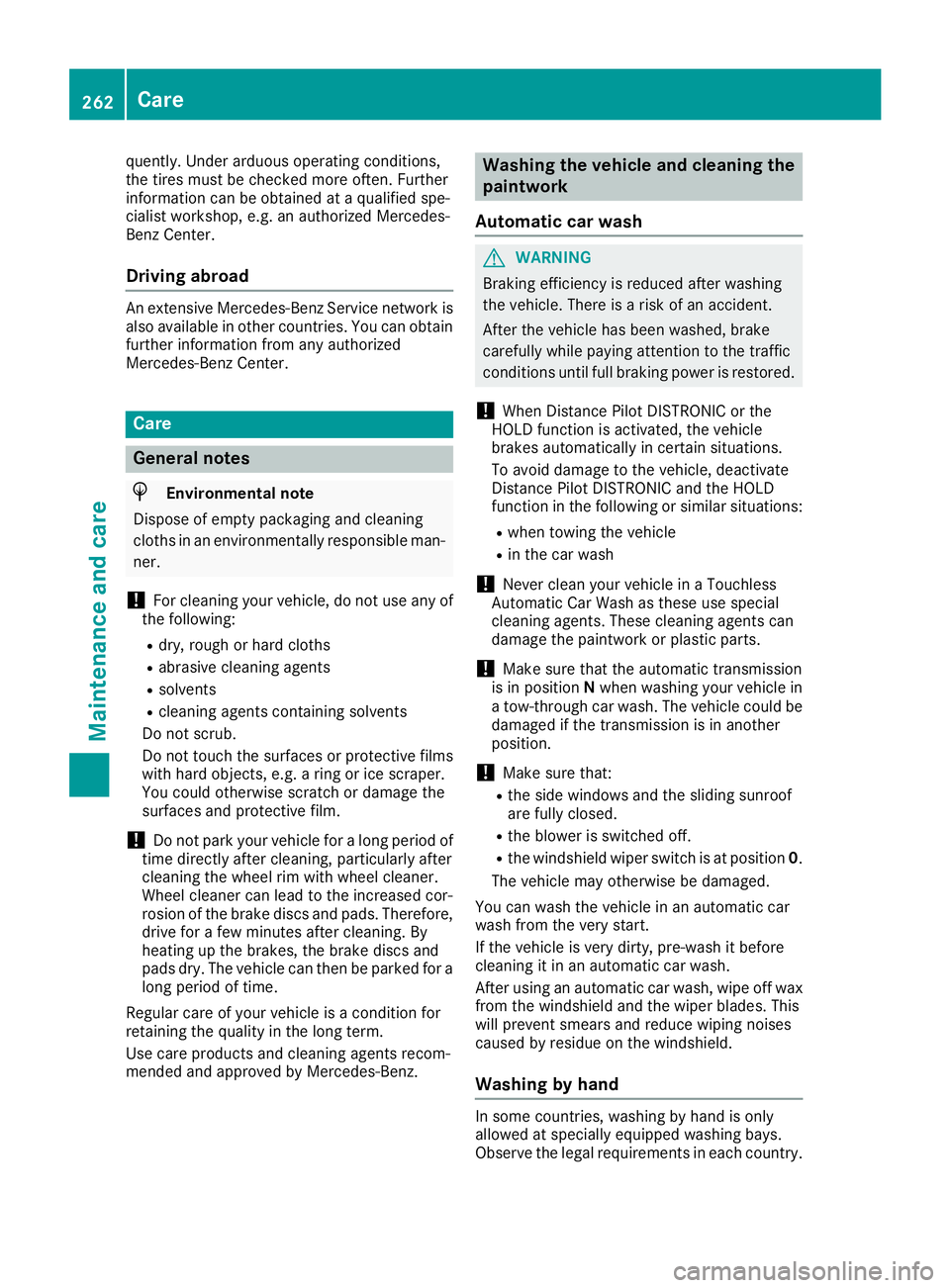
quently. Under arduous operatin gc onditions,
the tires must be checked more often. Further
information can be obtained at aq ualified spe-
cialist workshop, e.g. an authorized Mercedes-
Ben zC enter.
Driving abroad An extensive Mercedes-Benz Service network is
also available in other countries. You can obtain
further information from any authorized
Mercedes-Benz Center.
Care
General notes
H Environmental note
Dispose of empty packagin ga nd cleaning
cloths in an environmentally responsible man-
ner.
! For cleanin gy our vehicle, do not use any of
the following: R
dry, rough or hard cloths R
abrasive cleanin ga gentsR
solvents R
cleanin ga gent sc ontainin gs olvents
Do not scrub.
Do not touch the surfaces or protective films
with hard objects, e.g. ar ing or ice scraper.
You could otherwise scratch or damage the
surfaces and protective film.
! Do not park your vehicle for al ong period of
time directly after cleaning, particularly after
cleanin gt he wheel rim with wheel cleaner.
Wheel cleaner can lead to the increased cor-
rosion of the brake discs and pads. Therefore,
drive for af ew minutes after cleaning. By
heating up the brakes, the brake discs and
pads dry. The vehicle can then be parked for a
long period of time.
Regular care of your vehicle is ac ondition for
retaining the quality in the long term.
Use care product sa nd cleanin ga gent sr ecom-
mended and approved by Mercedes-Benz. Washing the vehicle and cleaning the
paintwork
Automatic car wash
G WARNING
Braking efficiency is reduced after washing
the vehicle. There is ar isk of an accident.
After the vehicle has been washed, brake
carefully while paying attention to the traffic
condition su ntil full brakin gp ower is restored.
! When Distance Pilot DISTRONIC or the
HOLD function is activated, the vehicle
brakes automatically in certain situations.
To avoid damage to the vehicle, deactivate
Distance Pilot DISTRONIC and the HOLD
function in the following or similar situations: R
when towing the vehicle R
in the car wash
! Never clean your vehicle in aT ouchless
Automatic Car Wash as these use special
cleanin ga gents. These cleanin ga gent sc an
damage the paintwor korp lastic parts.
! Make sure that the automatic transmission
is in position N when washing your vehicle in
at ow-through car wash. The vehicle could be
damaged if the transmission is in another
position.
! Make sure that: R
the side windows and the sliding sunroof
are fully closed. R
the blower is switched off. R
the windshield wiper switch is at position 0 .
The vehicle may otherwise be damaged.
You can wash the vehicle in an automatic car
wash from the very start.
If the vehicle is very dirty, pre-wash it before
cleanin gitinana utomatic car wash.
After using an automatic car wash, wipe off wax
from the windshield and the wiper blades. This
will preven ts mears and reduce wiping noises
caused by residue on the windshield.
Washing by hand
In some countries, washing by hand is only
allowed at specially equipped washing bays.
Observe the legal requirements in each country.262
Care
Maintenance and care